Schedule Bimonthly Number of issues 22 | ||
 | ||
Publication date May/June 1950 – November/December 1953 Similar Weird Science, The Vault of Horror, Crime SuspenStories, Two‑Fisted Tales, Tales from the Crypt | ||
Weird fantasy 21 ec comics 1st print and series original 1950 s williamson frazetta
Weird Fantasy is a science fiction anthology comic that was part of the EC Comics line in the early 1950s. The companion comic for Weird Fantasy was Weird Science. Over a four-year span, Weird Fantasy ran for 22 issues, ending with the November–December 1953 issue.
Contents
- Weird fantasy 21 ec comics 1st print and series original 1950 s williamson frazetta
- Weird fantasy 15 ec comics 1st printing series al williamson 3 stories wally wood and kamen
- Publication history
- Artists and writers
- Stories and themes
- Influences and adaptations
- Demise
- Reprints
- References
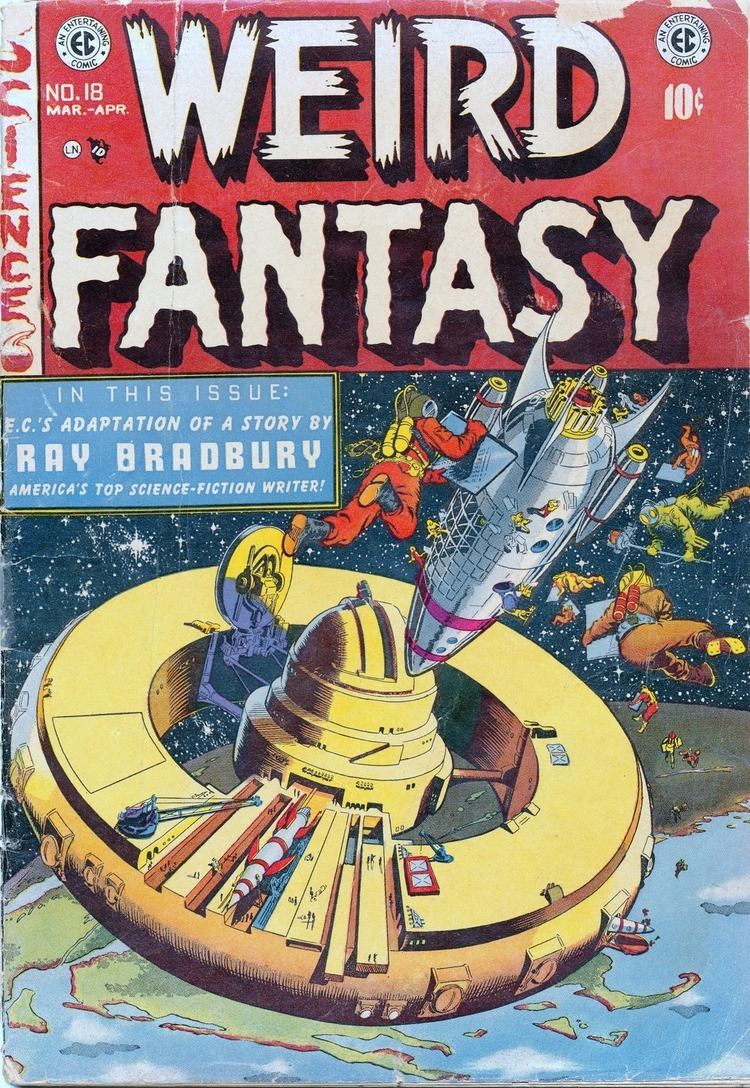
Weird fantasy 15 ec comics 1st printing series al williamson 3 stories wally wood and kamen
Publication history

The bi-monthly science-fiction comic, published by Bill Gaines and edited by Al Feldstein, replaced romance comic A Moon, A Girl... Romance with the May/June 1950 issue. Although the title and format change took effect with issue 13, Gaines and Feldstein decided not to restart the numbering in order to save money on second class postage. The Post Office took note, and starting with issue #6, all the issues were numbered correctly. Because of this, "Weird Fantasy #13" could refer to either the May/June 1950 issue or the actual 13th issue of the title, published in 1952. The same confusion exists for issues #14–17, #17 being the last issue published before EC reset the numbering.

Artist/writer Harry Harrison claims credit for originally turning Gaines on to the idea of publishing science fiction. Harrison has stated that he and fellow artist Wally Wood were interested in science fiction and supplied Gaines with a lot of science fiction material to read. Harrison had no editorial control over the contents of the comic aside from his own stories, and he left EC by the end of 1950.
Artists and writers

Cover illustrations were by Feldstein with the exception of two by Joe Orlando, one collaboration by Feldstein and Al Williamson, plus another collaboration by Williamson with Frank Frazetta. Artists who drew stories for this EC title were Feldstein, Frazetta, Williamson, Orlando, Wally Wood, Harvey Kurtzman, George Roussos, Harrison, Reed Crandall, Will Elder, Bernard Krigstein, Jack Kamen, John Severin and Mac Elkin. Writers in the early issues included Feldstein, Gaines, Kurtzman, Harrison and Gardner Fox. Gaines and Feldstein wrote nearly all stories from 1951–53.
Stories and themes
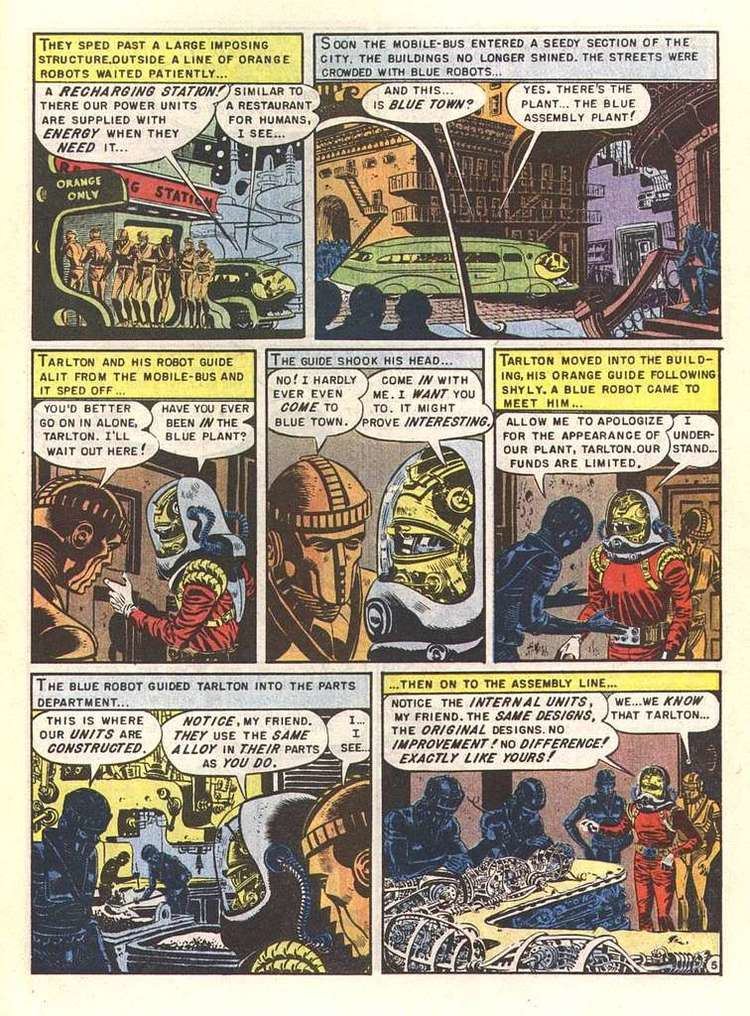
Creators Gaines and Feldstein made cameos in the stories "Cosmic Ray Bomb Explosion" (14, July–August 1950), "7 Year Old Genius" (7) and "The Expert" (14) and "The Ad" (14).

Issues 14 and 15 in 1952 ran EC Quickies, a format featuring two similarly themed stories, each three or four pages, in the space usually devoted to a seven or eight-page story.

In Weird Fantasy 17 (1953), Al Williamson illustrated "The Aliens". Three aliens head for Earth to prevent a nuclear war, but they arrive too late. Amid the devastation they find a copy of Weird Fantasy 17. When they read "The Aliens", they see that it had predicted their arrival. On the last page they see a picture of themselves looking at a comic book with a picture of themselves looking at... ad infinitum.
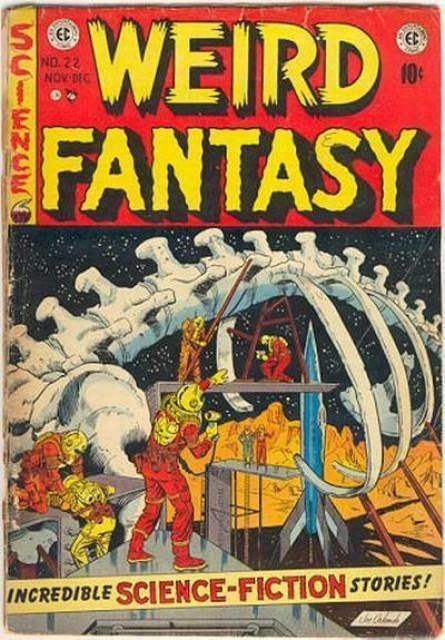
Quite possibly the comic's most controversial story was published in issue 18 in 1953. "Judgment Day" featured an astronaut who comes to a planet populated by orange and blue robots who hope to join the Galactic Republic. As he tours the planet, the astronaut, named Tarlton, realizes that blue robots are treated horribly and given fewer rights than the orange robots, despite the fact that they are identical except for the color of their exterior. Tarlton decides that because of this, the planet will not be allowed in the Galactic Republic. In the final panel Tarlton removes his helmet, revealing that he is black. This story was chosen for reprinting approximately three years later in Incredible Science Fiction, which resulted in an argument that caused Gaines to quit comics altogether.
Influences and adaptations
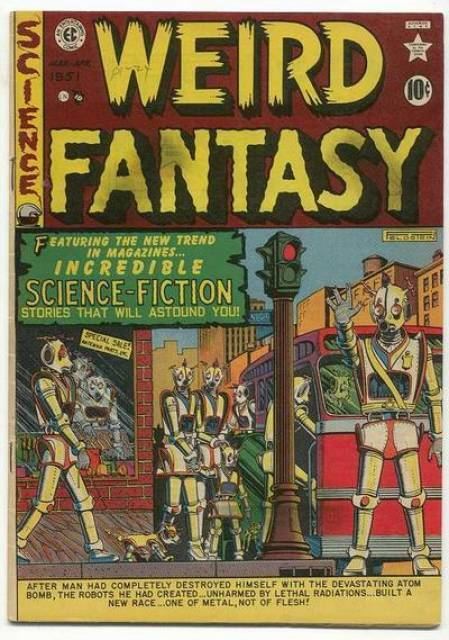
As with the other EC comics edited by Feldstein, the stories in this comic were primarily based on Gaines reading a large number of science fiction stories and using them to develop "springboards" from which he and Feldstein could launch new stories. Specific story influences that have been identified include the following:
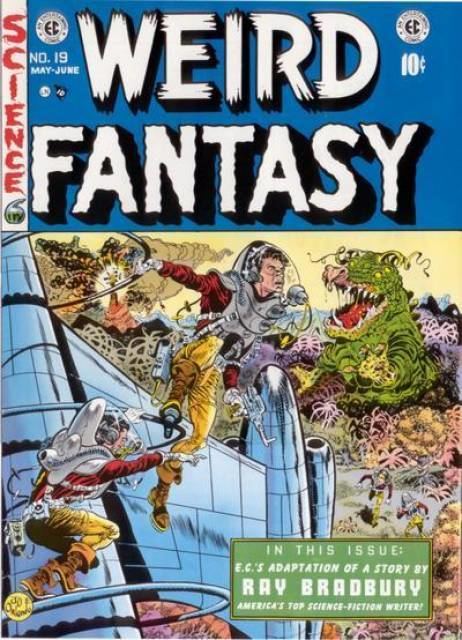
After their publication of "Home to Stay", Ray Bradbury contacted EC about their plagiarism of his work. They reached an agreement for EC to do authorized versions of Bradbury's short fiction. These official adaptations include:
Demise
EC's science fiction comics were never able to match the popularity of their horror comics like Tales from the Crypt, but Gaines and Feldstein kept them alive using the profits from their more popular titles. In the EC Library reprints, comics historian Mark Evanier theorizes that the short story format, where no story was longer than eight pages helped contribute to poor sales because the horror comics were much better suited for very short stories with shock endings than the science fiction comics. Evanier also ponders whether the very similar logo style of Weird Science and its companion comic Weird Fantasy, as well as similar cover subjects contributed to lower sales due to customers thinking they already owned the issues on sale. Historian Digby Diehl wondered whether having host characters like EC's horror comics would have helped the comics be more commercially successful.
When the poor sales became too much to handle, Weird Fantasy combined with companion comic Weird Science in 1954 to become Weird Science-Fantasy. As discussed in an "In Memoriam" feature in the final issue, every issue for the previous year and a half had lost money, and EC had no choice but to combine the two comics into one. Weird Science-Fantasy ran for seven issues before a title change to Incredible Science Fiction for four issues.
Reprints
As with many other EC titles, Weird Fantasy has been reprinted numerous times over the years. Ballantine Books reprinted selected stories in a series of paperback EC anthologies in 1964–66. All 22 issues were published in black and white in four hardbound volumes in 1980 as part of publisher Russ Cochran's The Complete EC Library. In addition, all 22 issues were reprinted in comic form in the mid-1990s by Cochran and Gemstone Publishing. This complete run was later rebound, with covers included, in a series of five softcover EC Annuals. Cochran and Gemstone planned to publish hardcover, re-colored volumes of Weird Fantasy as part of the EC Archives series, but Gemstone's financial troubles left this project in limbo. But the project may soon be revived under a new publisher. GC Press LLC, a boutique imprint established by Russ Cochran and Grant Geissman, announced in a press release dated September 1, 2011 that it is continuing the EC Archives series, with the first new releases scheduled for November 2011.
